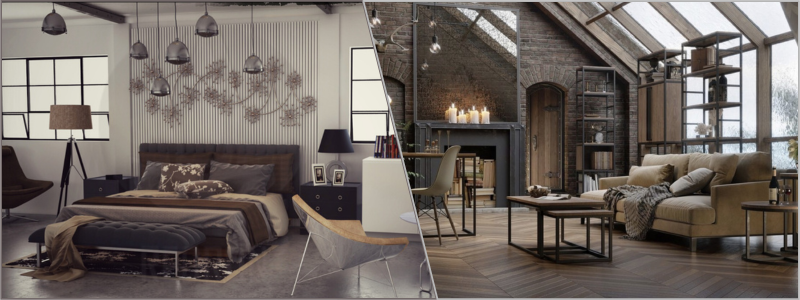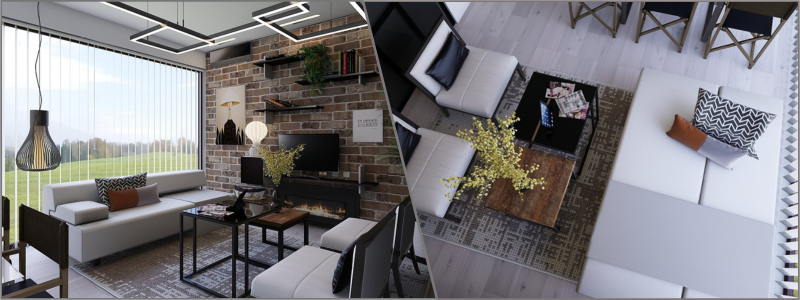Today’s article explores the varieties of dynamic 3D visuals in architecture and design services. Did you notice how the architecture and design services industry has been enjoying a colossal change with the rise of 3D technology, specifically rendering? Indeed, 3D technology simplifies transforming even the most basic ideas and concepts into visual masterpieces that speak so much before the actual groundbreaking. The most recent breakthroughs in technology have helped a lot in making architectural concepts more transparent and captivating.
What’s most interesting is that they also serve as the much-needed sandbox for innovation and experimentation. Digging deeper into the newest trends shaping the future of 3D visuals will tell you right away that this tool is no longer as simple an accessory as it once was. Instead, it has now become a true cornerstone in the nonstop evolution and development of designs and architectural concepts. High-quality dynamic 3D renders created by expert 3D architectural rendering firms are essential for presenting architecture and design projects.
Cad Crowd has years of experience working with the best design and architecture firms, and this allowed us to observe how 3D visualization and its purposes and techniques evolved over the years. Let’s take a look at what we learned.
 Table of contents
Table of contents
RELATED: Why companies need 3D visualization
It doesn’t matter if it’s for the purpose of a client presentation, a marketing promotion, or a competition bid; you’re expected to use visual materials that can convey your ideas down to the T. It’s an open secret that static images alone can no longer keep up with the extremely short attention spans of modern audiences. Expert 3D renders are now poised to become the new norm that will wow viewers, including the most perceptive ones.
Exploring the different versions of dynamic 3D visuals in architecture and design services
3D visuals in design and architecture
The shift from traditional blueprint designs to modern digital 3D renders is a real breakthrough in and of itself. The transformation endowed designers and architects with a larger-than-life tool that can come up with more accurate, detailed, and immersive representations of their ideas and concepts. What makes these 3D renders truly essential is the fact that they bring life to the spatial dynamics, lighting, and textures of future designs.
It’s no surprise, then, that 3D visuals have made an imprint in the design and architectural industries. Most of today’s rendering companies produce different types and forms of 3D renders. The following are only among the most popular formats that might change the game for you and your company:
RELATED: What is a 3D visualizer?
360-degree view
360-degree renderings that are full of life allow viewers to rotate realistic 3D models of buildings and inspect them from all sides. Out of all the common 3D visualization service types, 360-degree views are particularly at home for mobile apps and websites alike. These views are also more effective and impactful for commercial and residential projects as they make room for more scrupulous scrutiny from all angles.
3D animation
3D animations are no doubt some of the most engaging and versatile out of all 3D renders. With these animations, architects and designers can come up with a narrative or story around their ideas and throw in spectacular effects, music, voiceovers, transitions, and viewpoints. The format can also illustrate projects at different points of the day or seasons to add more context and depth to the overall visual experience. The use of this footage captured by drones in 3D animations can also endow a unique mishmash of cinematic quality and realism.
However, this might hamper creative freedom when it comes to lighting and weather conditions. It’s because they will look exactly like what the drone footage has captured. These animations are more cost-effective because you no longer need to build a detailed 3D landscape from the ground up. Unlike the rest of the 3D renders listed here, 3D animation professionals are also recommended unequivocally for aerial views.
RELATED: What factors influence 3D animation services rates, costs, and pricing for companies?

Machine learning and AI
Machine learning and artificial intelligence, or AI, are on the brink of redefining the creativity and efficiency of 3D renders. These two modern-day technologies are starting to put into autopilot the more tiring components of rendering, such as optimizing textures and lighting. This will give designers and architects more free time to pay attention to the creative facets of their projects.
Algorithms that are based on AI are also starting to recommend modifications in design to perk up functionality or aesthetics. It can possibly spearhead a new wave of encroachment in architectural and design industries.
Augmented reality
Augmented reality, or simply AR, can spread the digital details over those of the actual world. 3D AR/VR architectural services improve the physical environment using data and 3D models in an engaging and dynamic way. Using AI on-site makes it possible to superimpose the suggested designs over the existing surroundings. As a result, it provides a more tangible sense of context and scale. The state-of-the-art technology is a big help during design presentations while making the construction process enjoy better accuracy.
RELATED: Top 9 augmented reality apps for architecture & AR for architectural design firms
Cinemagraphs
Did those moving photos in the Harry Potter flicks blow you away? These are the perfect examples of cinematography: dynamic 3D visuals with minor repeated movements included. These cinematographic techniques can be used to capture the viewers’ attention in a more powerful way while maintaining the subtlety preferred. When these techniques are used in archviz, they can highlight specific design elements or set the favored ambiance or atmosphere. Cinemagraphs can breathe life into static images and heighten the emotional effects during presentations.
Hyper-realistic renders
The realism requirement in 3D renders has paved the way for substantial breakthroughs in simulating texture and lighting. Modern renders can now copy the multifaceted interplay of materials and light, from the rough textures of old wood to the morning sun’s soft flow on the façade of a building. Hyper-realistic visuals are appealing to the eyes and offer a more defined depiction of the finished product. The result is that clients can make better decisions along the way.
Immersive 3D tours
Immersive 3D tours created by 3D architectural visualization designers take the customary virtual experience to the next level with interactive elements. The tours feature real-time renders of environments that are dramatically realistic. Users can also engage in active interactions with such tours. They can customize the interior design or change the lighting, too.
RELATED: Mistakes to avoid when deciding an architectural visualization firm
BIM integration
BIM or Building Information Modeling, and 3D rendering can join forces to produce more accurate and efficient representations of design and architectural projects. The objective of BIM is to create digital representations of the buildings’ functional and physical characteristics. The data is visually brought to life with the help of 3D renders. The combination of these two technologies creates a seamless workflow. It’s because the changes crafted in the BIM model are shown in the 3D render in a snap of a finger. It encourages collaboration among everyone involved, from construction professionals to engineers, architects, and designers.
Green design and sustainable visuals
With the sustainable movement growing bigger across the globe and with the ever-increasing awareness about it, the architecture and design industries have also switched to green design and practices. 3D rendering services & 3D designers play a critical role in this newest trend as it helps envisage the sustainable features of buildings. These include the use of eco-friendly materials and natural lighting combined with energy efficiency. The renders call attention to the environmental advantages and present sustainable design principles and their practical and aesthetic applications and uses. All of these make green design more appealing and accessible to today’s clients.
3D virtual tours
3D virtual tours are a variety of 3D renders that allow users to find their way around a digital setting as if they were in that very area themselves. These tours also come in several categories. VR fusions, for example, allow users to interact with the design and customize it at the same time. Thanks to this, VR fusion offers a more personalized and immersive experience.

RELATED: How to create a virtual tour of homes with 3D rendering services
Meanwhile, the virtual maps are 3D visualizations from 3D visualizer experts that work hand in hand with Google Maps so that the audience can see future projects in the same context in real life. These 3D virtual tours are of great help for large-scale or complex projects because they provide a more interactive and meticulous exploration.
Virtual reality
Virtual reality, or VR, is one of the most cutting-edge of all 3D renders because of the completely immersive experience they offer. VR can whisk viewers right into the proposed project before its actual construction begins. Users can use VR headsets to explore every nook and cranny of a digital space to gain a better understanding and become more familiar with the materials and dimensions of the space.
VR is practical during the finalization of the design details with the clients. It ensures that every element is just as needed before the construction begins. Architects and designers can also use VR to the fullest by teaming up in a shared virtual space. It makes it a win-win choice for every phase of the project.
RELATED: How 3D virtual reality rendering is shaping the construction industry
The future of dynamic 3D visuals in design and architecture
With the entire world gearing up for the future, it‘s quite obvious that 3D renders will continue with their evolution. This is driven by their integration with more digital tools and technological advancements. The existing trends lay down the path for an exciting journey toward more intelligent, immersive, and sustainable design practices. These 3D visuals crafted by experienced 3D designers play a decisive role in shaping the built environment, and their possibilities are just starting to be realized.
In the ruthless world of architecture and design, the aptitude to present designs in an unforgettable and captivating way is a must for professionals who like to leave lasting impressions on their audience. It is where the different types of dynamic 3D visuals stand out the most. They provide architects and designers with a helpful toolbox of breakthrough formats that can take their presentations to the next level. It also encourages a more effective engagement with their target audience.
RELATED: All you need to know about 3D visualization for architectural design and CGI projects
How Cad Crowd can help
Do you feel like you can use a dynamic 3D visual that can highlight your design and architectural project in a way that is not like anything before? Cad Crowd has helped designers and firms come together to create 3D visualizations that translate to impact and profit, with our leading network of engineers and designers built from years of experience.
Contact Cad Crowd today to get those captivating visuals that everyone will love and appreciate!
